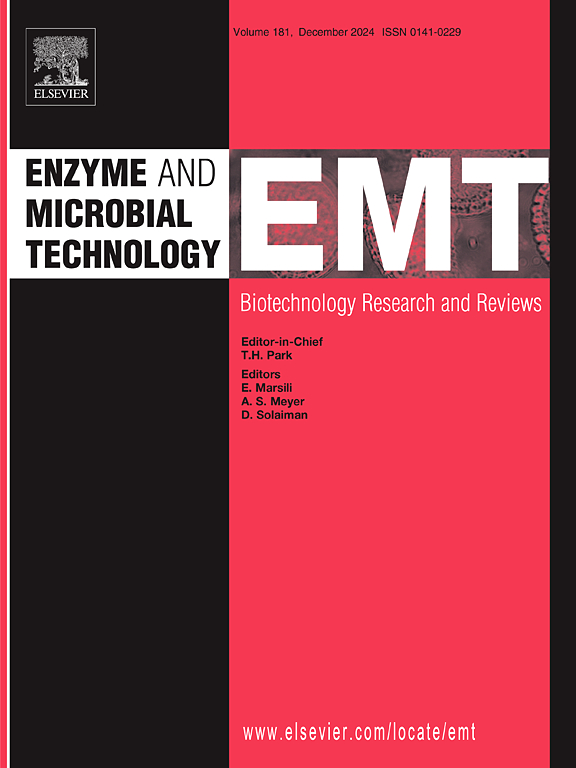Cell-free biocatalysis for co-production of nicotinamide mononucleotide and ethanol from Saccharomyces cerevisiae and recombinant Escherichia coli
IF 3.4
3区 生物学
Q2 BIOTECHNOLOGY & APPLIED MICROBIOLOGY
引用次数: 0
Abstract
Cell-free enzyme systems have emerged as a promising approach for producing various biometabolites, offering several advantages over traditional whole-cell systems. This study presents an approach to producing nicotinamide mononucleotide (NMN) by combining a Saccharomyces cerevisiae cell-free enzyme with a recombinant Escherichia coli cell-free enzyme. The system leverages the ATP generated by yeast during ethanol fermentation to produce NMN in the presence of nicotinamide (NAM) as a substrate. The optimal cell-free enzyme concentration and substrate concentration were investigated to maximize NMN production. The results showed that combined cell-free enzymes led to increased NMN and ethanol yields, with a maximum production of 1.5 mM NMN (2.7-fold) and ethanol production of 0.45 g/L achieved (1.6-fold) compared to individual cell-free enzymes. Furthermore, the study demonstrated that the protein concentration affected NMN production, with optimal production achieved at 5 g/L. This study demonstrates the potential of integrating multiple metabolic pathways in a single cell-free system, paving the way for the development of more efficient and sustainable bioproduction processes.
酿酒酵母和重组大肠杆菌协同生产烟酰胺单核苷酸和乙醇的无细胞生物催化研究。
无细胞酶系统已经成为生产各种生物代谢物的一种有前途的方法,与传统的全细胞系统相比,它提供了几个优点。本研究提出了一种将酿酒酵母无细胞酶与重组大肠杆菌无细胞酶结合生产烟酰胺单核苷酸(NMN)的方法。该系统利用酵母在乙醇发酵过程中产生的ATP在烟酰胺(NAM)作为底物存在的情况下产生NMN。研究了最佳的无细胞酶浓度和底物浓度,以最大限度地提高NMN的产量。结果表明,与单个无细胞酶相比,组合无细胞酶可提高NMN和乙醇产量,最大产量为1.5 mM NMN(2.7倍),乙醇产量为0.45 g/L(1.6倍)。此外,研究表明,蛋白质浓度影响NMN的产量,最佳产量达到5 g/L。这项研究展示了在一个单一的无细胞系统中整合多种代谢途径的潜力,为开发更有效和可持续的生物生产过程铺平了道路。
本文章由计算机程序翻译,如有差异,请以英文原文为准。
求助全文
约1分钟内获得全文
求助全文
来源期刊

Enzyme and Microbial Technology
生物-生物工程与应用微生物
CiteScore
7.60
自引率
5.90%
发文量
142
审稿时长
38 days
期刊介绍:
Enzyme and Microbial Technology is an international, peer-reviewed journal publishing original research and reviews, of biotechnological significance and novelty, on basic and applied aspects of the science and technology of processes involving the use of enzymes, micro-organisms, animal cells and plant cells.
We especially encourage submissions on:
Biocatalysis and the use of Directed Evolution in Synthetic Biology and Biotechnology
Biotechnological Production of New Bioactive Molecules, Biomaterials, Biopharmaceuticals, and Biofuels
New Imaging Techniques and Biosensors, especially as applicable to Healthcare and Systems Biology
New Biotechnological Approaches in Genomics, Proteomics and Metabolomics
Metabolic Engineering, Biomolecular Engineering and Nanobiotechnology
Manuscripts which report isolation, purification, immobilization or utilization of organisms or enzymes which are already well-described in the literature are not suitable for publication in EMT, unless their primary purpose is to report significant new findings or approaches which are of broad biotechnological importance. Similarly, manuscripts which report optimization studies on well-established processes are inappropriate. EMT does not accept papers dealing with mathematical modeling unless they report significant, new experimental data.
 求助内容:
求助内容: 应助结果提醒方式:
应助结果提醒方式:


